- Basic information
- Workshops and guides
- Managing references
- Library Lookup – your connection to the WU catalog
- Using Zotero in Word
- Working with PDF attachments and notes
Basic information
Installation
The Zotero reference management software is an open source program and can be downloaded free of charge on the Zotero homepage for MS Windows, Mac OS X, and Linux operating systems.
Tip: We recommend installing the Zotero browser plugin in order to get the most out of Zotero when importing from databases. The plugin is available for Firefox, Chrome, and Safari.
You will also need to install the appropriate plug-in to be able to use Zotero with your word processing software. Plug-ins are available for MS Word and LibreOffice.
Information for WU staff
To install Zotero on WU work computers, please download the program via the Software Center in your computer’s start menu. Updates for the software can be done independently by activating Check for updates under the tab Help in Zotero.
Zotero account
If you want to share your references with others or synchronize your reference library to different devices, you will need a free Zotero account, which you can set up on the Zotero homepage. The number of literature references you can save is unlimited, but for attached files (e.g. PDFs), storage space is limited to 300 MB. Additional storage space can be purchased if necessary.
A number of different apps are available for mobile devices, you can find out more here.
Please note: The data of Zotero accounts is processed outside of the European Economic Area (EEA). You can find further information on this here.
Workshops and guides
Library workshops
The WU Library regularly offers introductory courses for Zotero and other reference management software. You can find the current schedule on our website.
search_bar
In addition, every Tuesday you have the opportunity to visit the search_bar – no registration necessary! The search_bar offers advice on all questions concerning reference management.
Guides
Below you can find an overview of the most important functions and WU-specific settings.
Managing references
Creating references manually
- Select File » New Item or click the New Item button in the Zotero toolbar
- Select the document type: This will define which fields are available and how the citation and bibliographic entry will be formatted.
- Fill out the required bibliographic data. Please note the formal requirements for entering names.
Entering names
Zotero offers two options for entering names. You can switch between the options using the button next to the entry field:

In two-field mode, the author’s last name is entered in the first field and the first name (including aristocratic titles) in the second. One-field mode is used for entering the names of organizations, research institutions, or other facilities acting as author or editor.
For each new author, press the plus button for a new field where you can enter the name of a person or institution.
You can assign roles (author, editor, etc.) by clicking the Author ![]() button.
button.
Managing collections
Zotero allows users to create collections to sort references: Right-click on My Library and click on New Collection… or click on the New Collection… button ![]() to create a new collection. You can also make subcollections by right-clicking on an existing collection and selecting New Subcollection….
to create a new collection. You can also make subcollections by right-clicking on an existing collection and selecting New Subcollection….
Automatically adding references
Importing references
Most databases offer a number of different export options, and Zotero is compatible with several file formats. In most cases the formats RIS or BibTeX are available, both of which can be opened directly with Zotero or imported using File » Import.
Searching via ISBN, DOI or PMID
Zotero allows you to search for literature references via pre-existing numeric identifier (ISBN, DOI or PMID) and to import them directly into your database. Click on the symbol of the magic wand “Add Item(s) by Identifier” in the Zotero toolbar, enter the identifier, then press Enter.

Using the browser plugins
The most common method of importing literature references from databases, library catalogs, and other online sources is by using the browser plugins. These plug-ins recognize how the bibliographic data is formatted based on the site address and import it directly into your Zotero library.
The symbol to the right of the Zotero logo in your browser indicates that the plugin has detected embedded metadata on the page. Clicking on it will give you the option of saving the whole page as a literature reference or saving only the bibliographic data. Select Save in Zotero with DOI or Save in Zotero with ProQuest to be shown a dialog box for all entries on the page.
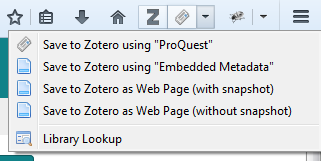
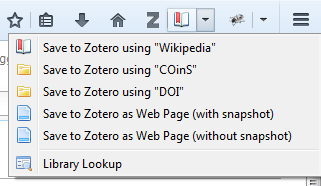

Library Lookup – your connection to the WU catalog
Once you have the title data of a document in Zotero, you can use the Library Lookup function to check if the document itself is available to you through the WU catalog.
Setting up Library Lookup
Open Zotero’s settings (Windows: Edit » Preferences, Mac OS: Zotero » Preferences).
A new window will appear. In that window, select Advanced at the top. Then, in the General tab, under OpenURL in the field Resolver, enter the URL https://openurl.wu.ac.at/resolve. Confirm this entry by clicking OK.
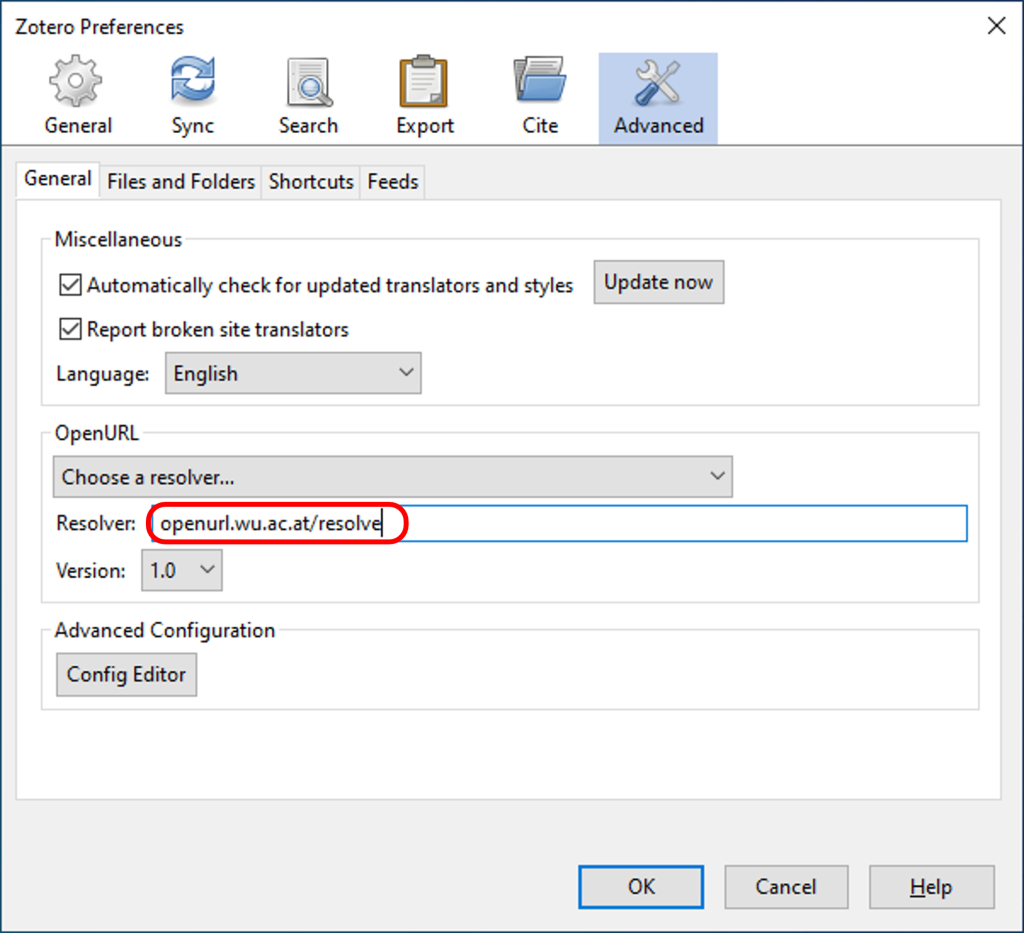
Using Library Lookup
Click once to select a record in your collection. Now, click the green “Locate”-arrow above the record’s information.
From the menu, choose Library Lookup. Zotero will open the page of the record in the WU Catalog in a browser window, allowing you direct access to the document, depending on its availability. To access a document online, you need to be connected to the WU network. You can find more details on how to access online-resources here.
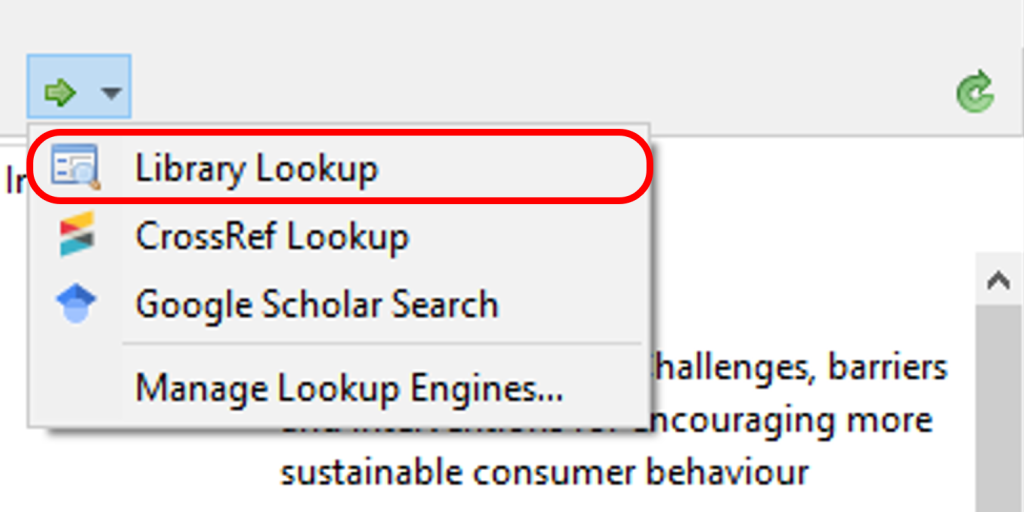
Using Zotero in Word
Managing citation styles
Citation styles determine how citations in the text and the bibliography are formatted. Zotero offers a large choice of different styles. Under Tools » Preferences » Cite » Styles you can select a style, or use the Get additional styles… function to import additional styles. If the style you need is not available in Zotero, please contact the library at library@wu.ac.at.
Installing the Word plug-in
Go to Edit » Preferences » Cite » Word Processors to install plugins for Zotero Standalone.
Document preferences
Entering your first citation will open the Document Preferences window, where you can determine the citation style, language, and other settings. You can click on the Document Preferences button ![]() in the Zotero toolbar in Word to change these settings later as required.
in the Zotero toolbar in Word to change these settings later as required.
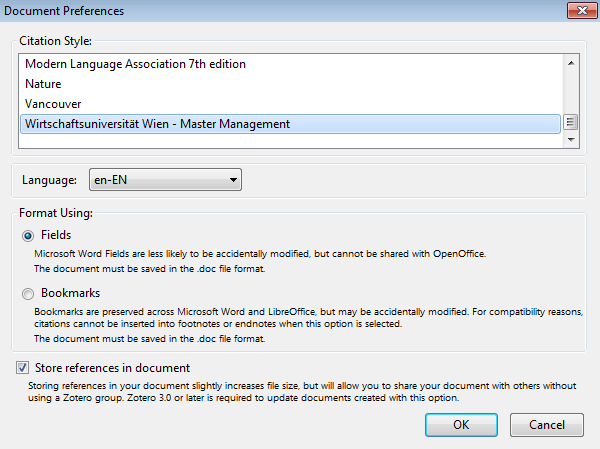
Inserting a citation
- In your text, place the cursor where you want to insert your citation.
- Click on Add/Edit Citation in the Zotero toolbar.
- Enter the author or title of your reference in the search window. You can restrict your results to the year of publication, as well.
- Select on the reference you want to insert.
- Click on the name to add any page numbers, prefixes, or suffixes.
- Press Enter.

If the selected citation style requires footnotes, a footnote with the citation will be automatically created.
Inserting secondary citations
Please note: Generally, secondary quotations are best avoided in academic writing and should only be used if it is impossible to obtain the original source.
Zotero can automatically format secondary quotations using the following steps:
- Insert both quotations (original and secondary) with Zotero, so that both sources appear in the bibliography.
- Type in the quotations as normal text in the desired format.
- Hide the Zotero quotations by marking the quote and activating the option Hidden in the Font menu (CRTL+D or right click » Font). You will still see the citations when editing your paper, but they will not show on a print-out or when exported as a PDF file.
Creating a bibliography
Zotero does not automatically create a bibliography. To create a bibliography, place your cursor where you want your bibliography to be inserted and click Add/Edit Bibliography  in the Zotero toolbar. A bibliography with all citations in the document will be inserted and any references added later will be automatically added to the bibliography.
in the Zotero toolbar. A bibliography with all citations in the document will be inserted and any references added later will be automatically added to the bibliography.
Editing and deleting citations
To add page numbers or prefixes like cf., see, etc., place your cursor in the reference to be edited and click Add/Edit Citation. A Zotero window will appear where you can enter your changes.
Use the Delete or Backspace keys on your keyboard to delete references.
Updating citations
When you have edited a reference in Zotero, press the Refresh button ![]() in the Zotero toolbar to update the reference in your database.
in the Zotero toolbar to update the reference in your database.
Working with PDF attachments and notes
When attaching PDFs to a title, they are automatically renamed according to the metadata of the parent entry. You can turn this feature on or off under Edit » Preferences » General. It also indexes the PDF, which allows the contents of the PDF to be searched in Zotero.
Double-click the title or directly on the attached PDF to open Zotero’s PDF reader and notes editor.

Here you can highlight the PDF, create notes, and collect image or table citations. To do this, select the appropriate tool from the toolbar at the top of the editor and a color for the markup.
The annotations are displayed on the left side. You can add your own comments and keywords (tags) to them. Annotations marked in this way can be shown or hidden by color or keyword selection.
Add annotations to notes
In the main Zotero window, right-click the title of a resource and choose Add Note from Annotations.
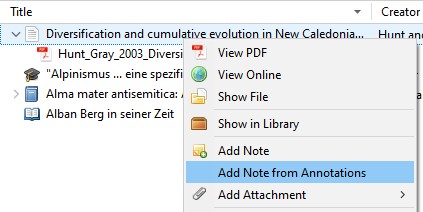
Zotero now creates a note with the title Annotations and the time it was created. When you select it, you will see the annotations and corresponding part of the text on the right. By clicking on the dots in the upper right corner, you can show or hide the annotation colors and evidence. Clicking on a citation allows you to jump directly to the cited title, edit or hide the reference to the text.

Insert notes into Word
The annotations can be added as citations to your Word document. To do this, click Add Note and – just as you would cite a title – select the note you want to insert. Zotero automatically inserts the entire content of the selected note.

Plug-ins
There are a number of plug-ins available to add extra features to Zotero. The full list of plug-ins can be found here.
